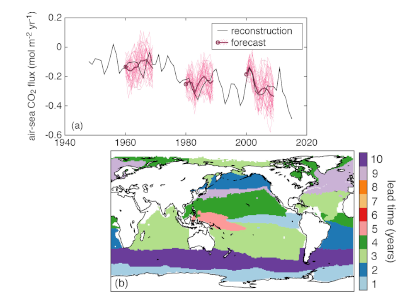Year-to-year changes in the flux of CO2 between the atmosphere and the ocean impact the global carbon cycle and climate system, and challenge our ability to verify fossil fuel CO2 emissions. A new study published in Earth System Dynamics suggests that these air-sea CO2 flux variations are predictable several years in advance.
A novel set of initialized forecasts of past air-sea CO2 flux from an Earth system model (Figure 1a) confidently predicts year-to-year variations in the globally-integrated flux up to two years in advance. At regional scales, the forecast lead time increases. The predictability of CO2 flux from the initialized forecast system exceeds that obtained solely from foreknowledge of variations in external forcing (e.g., volcanic eruptions) or a simple persistence forecast (e.g., CO2 flux this year will be the same as next year). The longest-lasting forecast enhancements are in the subantarctic Southern Ocean and the northern North Atlantic (Figure 1b).

Figure 1: (a) Forecasts of the past evolution of air-sea CO2 flux in the South Pacific using an Earth System model indicate the potential to predict the future evolution of this quantity. (b) In each biome, the maximum forecast lead time in which the initialized forecast of air-sea CO2 flux beats out other forecast methods.
These results are particularly meaningful for those forecasting year-to-year changes in the global carbon budget, especially as these forecasting efforts are blind to the externally-forced variability in advance (i.e., the external forcing of the future is unknown). In this way, forecasts of air-sea CO2 flux variations can help to inform future predictions of land-air CO2 flux and atmospheric CO2 concentration.
Authors:
Nicole Lovenduski (University of Colorado Boulder)
Stephen G. Yeager (National Center for Atmospheric Research)
Keith Lindsay (National Center for Atmospheric Research)
Matthew C. Long (National Center for Atmospheric Research)
See also the OCB Ocean-Atmosphere Interactions: Scoping directions for U.S. research Workshop to be held in October 1-3, 2019




